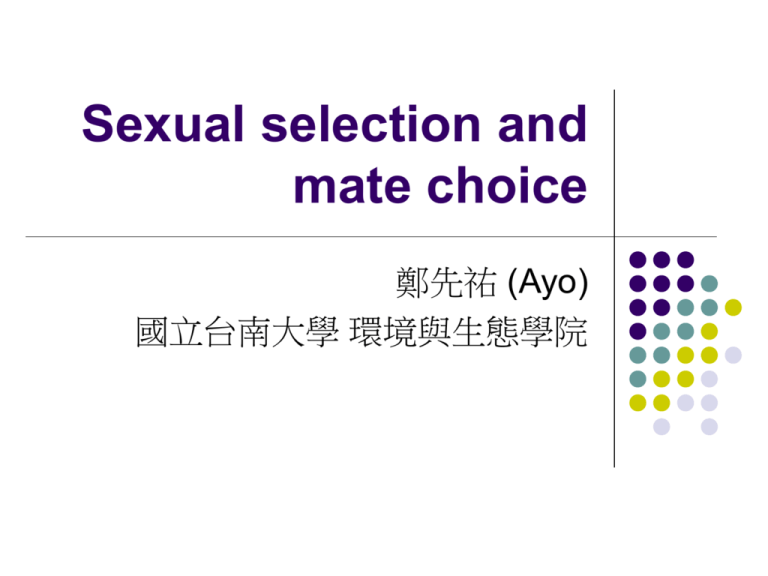
Sexual selection and
mate choice
鄭先祐 (Ayo)
國立台南大學 環境與生態學院
性擇與交配選擇
A central concern in sexual selection is
understanding how female mating
preferences evolve.
How can female mating preferences evolve if
there is no effect of preference on female
fitness?
Two hypotheses, runaway sexual selection
and good genes.
參閱 Andersson (1994) Sexual selection
sexual selection
2
Sexual selection and mate
choice
8.1 introduction
8.2 Sexual selection by female mate choice
8.3 The null model for the evolution of female mating
preferences
8.4 Direct selection on female mating preferences
8.5 Indirect selection on female mating preferences :
Fisher’s runaway sexual selection
8.6 Indirect selection on female mating preferences:
good genes hypotheses
sexual selection
3
Sexual selection and mate
choice
8.7 Interacting forces
8.8 Multiple traits and their preferences
8.9 Mate copying: a new horizon?
8.10 summary
sexual selection
4
8.2 Sexual selection by female
mate choice
The female mate choice is influenced by
variation in male traits.
Elaborate trains of peacocks, the hyperdeveloped
tail fins forming the sword of swordtails, the
complex acoustic repertoire of songbirds and
frogs, pheromones of moths.
這些特徵,有些增加雄性的死亡率。
有三個研究的途徑:functional, mechanistic,
historical approaches.
sexual selection
5
Three kinds of approaches
Functional approaches are concerned with the
behavioural interactions that bring about mate
choice and how this generates selection on male
traits and female preferences.
Mechanistic studies attempt to identify the
physiological process underlying mating preferences.
Historical approaches acknowledge that extant traits
and preferences have experienced a long history of
selection and constraints that influence their current
expression.
sexual selection
6
三種途徑間的關係
sexual selection
7
8.3 The null model for the evolution of
female mating preferences
Kirkpatrick and Ryan (1991), the evolution of
female mating preferences (Fig. 8.3)
The null model assumes the female
preference is a constant which predicts trait
evolution.
但是 female preference 有可能會改變。
sexual selection
8
Fig. 8.3 (a) under direct
selection, mating
preference genes also
affect female survival or
fecundity.
sexual selection
9
Fig. 8.3 (b) in a
runaway process,
the equilibrium
curve becomes
unstable.
sexual selection
10
8.4 Direct selection on female mating
preferences
8.4.1 Fecundity
8.4.2 Pleiotropic (多型的) effects
8.4.3 Historical studies of sensory biases and
sensory exploitation
sexual selection
11
8.4.1 fecundity effects
In many cases a female’s mate choice has an
immediate effect on her reproductive success;
when males offer parental care, defend
young or feed their mates.
In resource-based mating systems, direct
selection on preference is expected to be the
rule.
sexual selection
12
Fecundity effects
Robertson(1990) and Bourne (1993), two frog
species, females select mates of a size that
maximizes fertility rates.
Eisner & Meinwald (1995) 蛾, pyrrolizidine
alkaloids (Pas)保護免於predation.
這種Pas 是取食獲得的。
雄性的使用作pheromone, 於交配的時候,可透過
spermatophore 傳送給雌性。
sexual selection
13
8.4.2 Pleiotropic effects
非直接的天擇,其他的管道
譬如:water mites,雄性的靠水面的震動,吸
引雌性,誤以為是獵物
Reproductive character displacement
(Gerhardt, 1994)
sexual selection
14
8.4.3 Historical studies of sensory
biases and sensory exploitation
The sensory exploitation hypothesis predicts that
the evolution of sexually selected traits is influenced
by these pre-existing sensory biases.
This generates a prediction about the historical
pattern of traits – that is distinct from the prediction
of good genes and runaway sexual selection in
which the preference and trait evolve in concert.
One can discriminate between these two sets of
hypotheses: Sensory exploitation vs. indirect
selection (good genes and runaway)
sexual selection
15
Sensory exploitation
hypothesis
The tungara frog produces a call consisting of
a whine and a chuck.
The whine is always present and is
necessary and sufficient to elicit mate
recognition from females.
The chuck is not always produced, but when
added to the whine it increases the
attractiveness of the call to females as well
as to frog-eating bats (Ryan, 1985).
sexual selection
16
Fig. 8.4 Phylogenetic relationships of frogs of the P. pustulosus
species complex showing the advertisement calls of each
species.
sexual selection
17
The most parsimonious explanation for the
occurrence of a chuck preference in both
clades within the species group is that the
preference is shared from a common
ancestor.
A pre-existing preference.
sexual selection
18
8.5 Indirect selection on mating preferences:
Fisher’s runaway sexual selection
Fisher’s theory of runaway sexual selection
has been a difficult one to evaluate
empirically.
This might be because the runaway process
is very rapid and thus unlikely to be observed.
sexual selection
19
8.5.1 genetic correlation of trait
and preference
Bakker (1993), sticklebacks , 不同的特徵(基
因型)各自喜歡相類似特徵的對象。
Wilkinson and Reillo (1994) conducted
bidirectional selection experiment on eye
span of stalk-eyed flies. 經過13世代,長眼的
後代,仍是喜歡長眼的,短眼的則是喜歡短眼
的。
There was a positive genetic correlation
between trait and preference.
sexual selection
20
8.6 good genes hypotheses
The focus of good genes studies can be
classified into four categories
(i) the general relationship between ornament
elaboration and offspring viability
(ii) the hypothesis of female choice for parasite
resistance genes
(iii) female choice of trait asymmetry as an
indicator of genetic quality
(iv) choice for genetic complementarity.
sexual selection
21
8.7 interacting forces
Direct selection, runaway selection and selection for
good genes are often portrayed as mutually exclusive
hypotheses for the evolution of females preferences.
This need not be the case.
這些不同的因素是有可能相互同時存在。
Searcy (1992), song repertoires were initially favoured
by a pre-existing preference for complex auditory
stimulation, but larger repertoires and the preference
for them coevolved through a runaway or a good
genes processes.
sexual selection
22
8.8 multiple traits and their
preferences
Some studies have demonstrated empirically
that females do attend to more than on trait.
Moller and Pomiankowski (1993) indicated
that multiple sexual ornaments are more
likely in lek breeding and other polygynous
species of birds while single sexual
ornaments seem to be the rule in
monogamous species.
sexual selection
23
8.9 mate copying: a new
horizon?
Recent studies have shown that mating
preferences can be influenced by social cues.
Females copy the mate choice of others (Gibson
and Hoglund, 1992)
Mate copying also can occur between
species.
Schlupp, et al. (1994) studies mating preferences
in a sexual-asexual species complex of mollies,
the sailfin molly and the Amazon molly.
sexual selection
24
8.10 summary
Sexual selection studies have moved from the single
debate over Fisher’s runaway sexual selection
versus selection fro good genes.
Direct selection had always been considered an
important influence on preferences in resourcebased mating systems.
There is some strong support for the genetic
correlations between trait and preference.
Historical approaches have introduced a new
dimension in attempting to reconstruct the history of
traits and preferences.
sexual selection
25
問題與討論
http://mail.nutn.edu.tw/~hycheng
sexual selection
26





